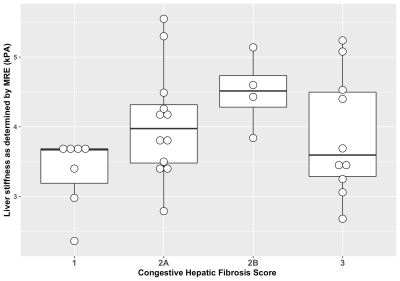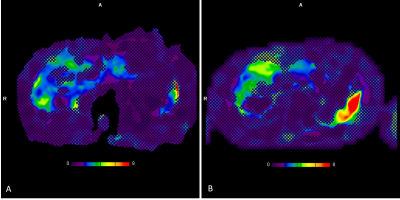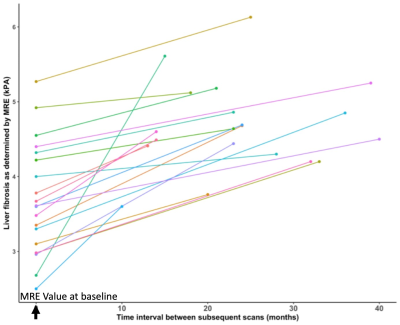2400
MR Elastography-Based Staging of Liver Fibrosis in Fontan Associated liver Disease is Confounded by the Effects of Venous Congestion
Suraj D Serai1, Adarsh Ghosh1, Benjamin J Wilkins2, Anne Marie Cahill1, David M Biko1, Elizabeth Rand3, Jack Rychik4, and David J Goldberg4
1Radiology, The Children's Hospital of Philadelphia, Philadelphia, PA, United States, 2Pathology, The Children's Hospital of Philadelphia, Philadelphia, PA, United States, 3Hepatology, The Children's Hospital of Philadelphia, Philadelphia, PA, United States, 4Cardiology, The Children's Hospital of Philadelphia, Philadelphia, PA, United States
1Radiology, The Children's Hospital of Philadelphia, Philadelphia, PA, United States, 2Pathology, The Children's Hospital of Philadelphia, Philadelphia, PA, United States, 3Hepatology, The Children's Hospital of Philadelphia, Philadelphia, PA, United States, 4Cardiology, The Children's Hospital of Philadelphia, Philadelphia, PA, United States
Synopsis
In patients with Fontan, although liver stiffness has been found to increase significantly with age and has been directly correlated with diminished cardiac function, the increased liver stiffness could be influenced by underlying conditions of vascular congestion. The purpose of this study was to compare stiffness as measured by MRE localized by liver biopsy with histological results from biopsy, and to determine the change in MRE defined liver stiffness over time. Our findings have important implications for how liver MRE might be a useful tool in following the progression of liver stiffness longitudinally in patients with Fontan associated liver disease.
Purpose
Fontan-associated liver disease (FALD) is associated with a risk of cirrhosis and hepatocellular carcinoma. Currently, liver biopsy is the gold standard for diagnosing liver fibrosis. Magnetic resonance elastography (MRE) is a novel non-invasive method of assessing liver stiffness, which may indicate development of FALD. While measurements of liver stiffness have shown promise for assessing the global severity of FALD, the variable effect of venous congestion on liver stiffness in Fontan patients may confound the staging of fibrosis with MRE. The purpose of this study was to compare targeted and global liver stiffness measured by MRE with histological findings of an ultrasound guided liver biopsy in a pediatric population of patients who have Fontan palliation, and to further assess the relationship between liver stiffness and fibrosis stage.Methods
This was an IRB-approved, retrospective, single institution review of pediatric patients with Fontan palliation who had both an MRE study and a percutaneous liver biopsy between 2015 and 2019. Patients with a maximum interval of 3 months between biopsy and MRE were included. Targeted liver stiffness was measured by freehand region of interest (ROI) drawn at the site of needle biopsy as directed by the reported biopsied liver segment and biopsy needle throw length. Targeted and global liver stiffness was compared with a quantification of liver fibrosis measured by percentage of Sirius Red (%SR) staining of biopsy samples. We also compared MRE values with three other biopsy scoring methods: Ishak, Scheuer/Ludwig-Batts/Metavir, and congestive hepatic fibrosis score (CHFS). Additionally, in patients who had two or more MRE studies, we compared global liver stiffness for longitudinal assessment.Results
Thirty-four patients were included in the study, with a mean age of 16.2 years (SD = 2.3 years; 26 males). There was no statistically significant correlation between MRE derived liver stiffness and Ishak score (p = 0.12), Metavir score (p = 0.07), and CHFS score (p = 0.10). Also, there was no statistically significant correlation between the %SR staining and MRE determined liver stiffness obtained from measurements of the entire liver (r = 0.066, p = 0.7) or targeted measurements obtained from the site of liver biopsy (r = -0.11, p = 0.54) Twenty patients had multiple MRE studies, with a mean age of 16.5 years (SD = 2.9 years; 13 males), and these showed a statistically significant increase in mean liver stiffness from 3.72 ± 0.85 to 4.68 ± 0.59 (26% increase) within an average period of 24 ± 9 months (p<0.001).Conclusion
The increase in mean liver stiffness over time observed in this study parallels the natural history of FALD and provides support for further evaluation of liver stiffness as a biomarker for longitudinal progression. The lack of correlation of liver stiffness with fibrosis stage observed in this study is consistent with prior studies that have indicated that the effects of venous congestion in Fontan patients can confound the use of liver stiffness as a biomarker for fibrosis as assessed by percentage of SR staining, Ishak score, Metavir score, and CHFS score. These results provide motivation for further development of MRI-based biomarkers to increase specificity in assessment of FALD.Clinical Significance
Liver stiffness assessed by 2D MRE is not a reliable method for staging liver fibrosis in Fontan patients, due to the variability of the co-existing effects of hepatic venous congestion on liver stiffness.Acknowledgements
No acknowledgement found.References
Serai SD, Wallihan DB, Venkatesh SK, Ehman RL, Campbell KM, Sticka J, Marino BS, Podberesky DJ (2014) Magnetic resonance elastography of the liver in patients status-post fontan procedure: feasibility and preliminary results. Congenital heart disease 9:7-14.Figures

Box-and-whisker plots showing the histological grades
assigned to the cases in our study using the Congestive Hepatic Fibrosis
Score, and the MRE-derived liver stiffness
(kPa).

MRE
stiffness maps of a 15-year-old male Fontan patient demonstrating the impact of
temporal liver stiffness measurements. (A) Liver stiffness = 2.5 kPa and
(B) same patient, liver stiffness = 3.6 kPa (time between two
consecutive MRE scans = 10 months). Notice the increasing green and red colors
with the same scale, indicating an increase in stiffness.

Plot of
change in MRE-derived mean liver stiffness over serial MRE measurements. Our
results demonstrate a significant increase in the stiffness of
longitudinal MR elastographies.
DOI: https://doi.org/10.58530/2022/2400